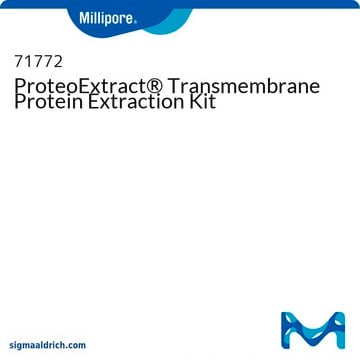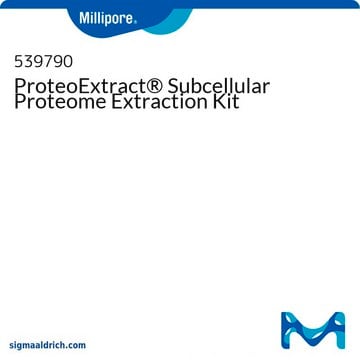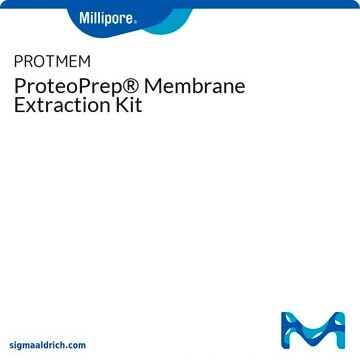444810
ProteoExtract® Native Membrane Protein Extraction Kit
Synonyme(s) :
Membrane protein extraction kit
About This Item
Produits recommandés
Utilisation
sufficient for 20 extractions
Fabricant/nom de marque
Calbiochem®
Conditions de stockage
OK to freeze
Technique(s)
protein extraction: suitable
Entrée
sample type: mammalian tissue
Conditions d'expédition
ambient
Température de stockage
2-8°C
Description générale
Composants
Avertissement
Principe
• Adherent tissue culture cells
• Suspension grown tissue culture cells
• Frozen cell pellets
• Tissues
Notes préparatoires
Stockage et stabilité
Store at 4°C.
• Extraction Buffers I & II
The Extraction Buffers I and II can be stored at 4°C for up to 6 month.
For prolonged storage, freeze the buffers in convenient aliquots at -20°C. Before extraction, buffers must be thawed at room temperature (RT). After thawing, mix components by gently shaking or vortexing. Avoid repeated freezing and thawing!
• Protease Inhibitor Cocktail
The Protease Inhibitor Cocktail is supplied in DMSO and can be stored at 4°C up to 6 months. For prolonged storage, freeze the cocktail in convenient aliquots at -20°C. During the sample preparation procedure it must be kept at RT to prevent freezing of DMSO.
Informations légales
Mention d'avertissement
Warning
Mentions de danger
Conseils de prudence
Classification des risques
Aquatic Chronic 3 - Eye Irrit. 2 - Skin Irrit. 2
Code de la classe de stockage
10 - Combustible liquids
Certificats d'analyse (COA)
Recherchez un Certificats d'analyse (COA) en saisissant le numéro de lot du produit. Les numéros de lot figurent sur l'étiquette du produit après les mots "Lot" ou "Batch".
Déjà en possession de ce produit ?
Retrouvez la documentation relative aux produits que vous avez récemment achetés dans la Bibliothèque de documents.
Notre équipe de scientifiques dispose d'une expérience dans tous les secteurs de la recherche, notamment en sciences de la vie, science des matériaux, synthèse chimique, chromatographie, analyse et dans de nombreux autres domaines..
Contacter notre Service technique









